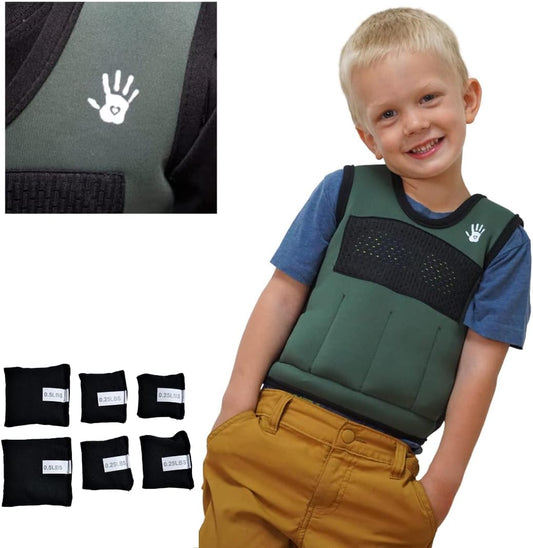Introduction:
The use of weighted vests for children is a topic that should be approached with caution and under the guidance of a healthcare professional or therapist. Weighted vests are sometimes used as a sensory tool for children with certain developmental or sensory processing issues. However, there is not a one-size-fits-all answer to how long a child should wear a weighted vest, as it depends on the individual child's needs and the recommendations of their healthcare team.
For kids with typical muscle tone, 5 to 10% of the child's body weight is best. Wear time should be 20 to 50 minutes based on convenience. For example, if the student is going to a class where he could benefit from vest wear, I would recommend leaving it on for the duration of that class/subject. So, it varies from child to child and the scenario in which he/she is in would determine the overall usage and duration of wearing a weighted vest.
When a weighted vest cannot be used?
There are certain scenarios in which a weighted vest is not prescribed. However, for certain activities, a weighted vest can be quite beneficial. There are limits, and trying any sort of “skilled” movement while wearing one is generally a mistake. While weighted vests can be beneficial for various workouts and activities, there are situations where they may not be suitable or advisable. Here are some instances when a weighted vest may not be recommended. These are mentioned below:
1. Medical Conditions: Individuals with certain medical conditions, such as cardiovascular problems, respiratory issues, joint problems, or musculoskeletal disorders, should consult with a healthcare professional before using a weighted vest. The additional load can exacerbate existing health issues.
Injuries: If you have any existing injuries, especially those affecting your back, shoulders, or spine, it is crucial to consult with a healthcare professional or physiotherapist before using a weighted vest. The added weight may strain injured areas and hinder the healing process.
2. Pregnancy: Pregnant individuals should avoid using weighted vests, especially during the later stages of pregnancy. The extra weight can place additional stress on the body, affecting balance and potentially increasing the risk of injury.
3. Children: Weighted vests are generally only recommended for children with proper supervision and guidance. Children's bodies are still developing, and adding extra weight can impact their growth and development.
4. Overtraining or Fatigue: If you are already tired or experiencing overtraining, adding extra weight with a vest may increase the risk of injury and hinder recovery. It's essential to listen to your body and give it adequate rest.
Is it OK for a child to wear a weighted vest all day?
As we all are aware, from the saying that “excess of anything is bad”. The same applies here, as it is not advisable to wear a weighted vest for the whole day. It is likely to make you very tired and could cause soreness and muscle burn in various parts of your body.
While weighted vests can be a useful tool for certain activities like workouts or specific training purposes, wearing them for extended periods may have potential drawbacks. Some key considerations in this regard are mentioned below:
1. Muscle Strain: Wearing a weighted vest for an extended period may place additional stress on your muscles and joints, potentially leading to fatigue, strain, or even injury.
2. Posture Issues: Carrying extra weight for a long time can affect your posture and potentially lead to discomfort or musculoskeletal issues.
3. Breathing and Circulation: A weighted vest may affect your breathing and circulation, especially if it is too tight or if the added weight is substantial. This could potentially impact your cardiovascular health.
4. Individual Differences: People vary in terms of fitness levels, existing health conditions, and how their bodies respond to different stimuli. What may be suitable for one person might not be for another.
5. Consultation with a Professional: Before using a weighted vest for extended periods, it is advisable to consult with a fitness professional or healthcare provider. They can provide personalized advice based on your specific health and fitness situation.
How heavy should a weighted vest be for a child?
When considering a weighted vest for a child, it is important to prioritize their safety and well-being. The American Academy of Pediatrics (AAP) does not recommend the use of weighted vests for typically developing children. However, in some cases, occupational therapists may suggest them as part of a sensory integration therapy plan for children with specific sensory processing disorders or developmental challenges.
The child's weighted vest should be 5-10% of their body weight. So, if your child is 40 lbs, the vest weight would be 2-4 lbs. This is important as you do not want to overstrain their bodies with more weight than what is safe. The weight should be evenly distributed as much as possible.

Shop Weighted Vest For Kids From Sensory4U
What are the rules for wearing weighted vests?
Weighted vests are commonly used in fitness training to add resistance to various exercises, such as walking, running, or bodyweight exercises. Start with no extra weight in the vest, and slowly add more as you get stronger and more confident with your form while doing exercises. A good general rule for safety is to use no more than 10% of your body weight. So, if you weigh 150 pounds, do not exceed 15 pounds on the vest.
It is important to follow certain guidelines to use weighted vests safely and effectively. Here are some general rules for using weighted vests:
1.Start Light: If you are new to using weighted vests, start with a lighter weight and gradually increase it as your strength and endurance improve.
2. Consult a Professional: Before incorporating a weighted vest into your workout routine, especially if you have any pre-existing health conditions or concerns, it is advisable to consult with a fitness professional or healthcare provider to ensure it is suitable for you.
3. Gradual Progression: Increase the weight gradually over time. Adding too much weight too quickly can increase the risk of injury. Aim for a progressive approach to allow your muscles and joints to adapt.
4. Limit Duration: Avoid wearing a weighted vest for extended periods, especially during activities that involve a lot of impact, as this can strain your muscles and joints.
5. Stay Hydrated: The additional weight can increase the intensity of your workout and lead to increased sweating. Stay well-hydrated to prevent dehydration.
When should I train with a weighted vest on?
Training with a weighted vest can be a beneficial addition to your workout routine, but it is important to use it wisely to avoid potential risks or overtraining. Here are some scenarios where using a weighted vest might be appropriate:
1. Strength Training: Wearing a weighted vest into strength training exercises like squats, lunges, and push-ups can increase resistance and challenge your muscles, promoting strength and stamina.
2. Cardiovascular Workouts: Wearing a weighted vest during activities like walking, jogging, or hiking can enhance cardiovascular benefits by increasing the intensity of the workout. This can help improve endurance and burn more calories.
3. Body weight exercises: When performing bodyweight exercises like pull-ups, dips, or box jumps, a weighted vest can add resistance, making these exercises more challenging and promoting muscle development.
How long does it take to see the results of a weighted vest?
The time it takes to see results from using a weighted vest can vary from person to person depending on several factors such as fitness level, the intensity of workouts, and the overall health condition. Additionally, the specific results you are looking for, such as increased strength, endurance, or calorie burn, may also influence how quickly you notice changes.
Generally, incorporating a weighted vest into your workouts can lead to quicker improvements in cardiovascular fitness, endurance, and calorie burning as compared to other traditional unweighted exercises. However, it is essential to use the vest appropriately and progressively increase the load to avoid injury.
Can you lose weight faster with a weighted vest?
A weighted vest can help you burn more calories, which can lead to weight loss over time. How much depends on how heavy the vest is and how fast/far you walk, but one study found that wearing a 10-pound vest while walking at a moderate pace burns an extra 100 calories over an hour.
A weighted vest adds resistance to your body, making activities like walking, running, or bodyweight exercises more challenging. This increased resistance can elevate your heart rate and calorie expenditure during these activities, potentially leading to more calories burned compared to the same activities without the vest.





